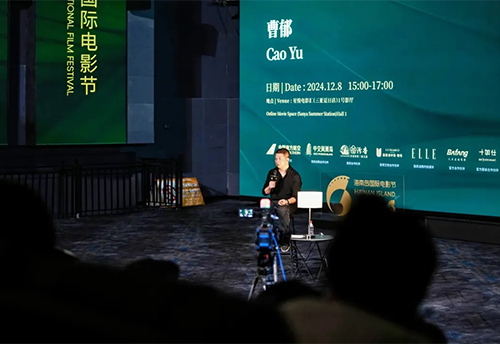- Golden Coconut International Jury Official Selection of Golden Coconut Award Award list Reviews of the Golden Coconut Award
- Line-up Screening by the Sea Around the Island
- HIIFF Talents Master Class Forum Carnival
- Competition Panorama Industry Events & Activities Information
- Cooperation Official Partners Contact Us
- Introduction Archives
- Film Submission Journalist Registration Visitor Registration Volunteers Join Masterclass Official Agenda Screening Schedule
Cao Yu’s Masterclass | Between Light and Shadow: The Emotional and Technological Resonance of the Soul
date:2024-12-09 source:Hainan Island International Film Festival
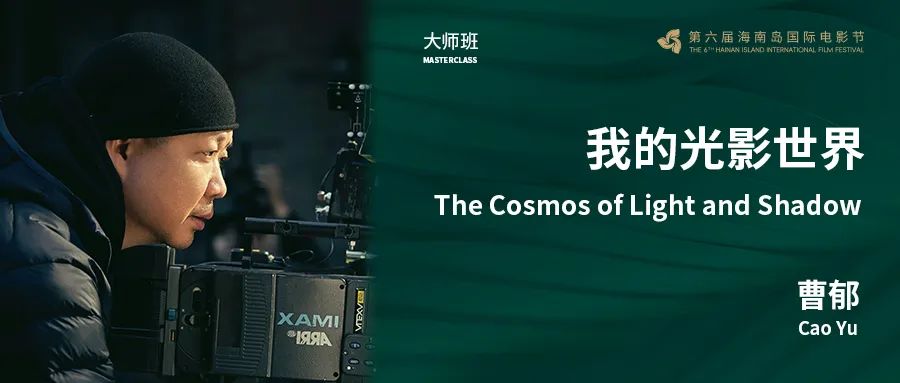
Cao Yu’s cinematic style is renowned for its “poetic realism,” where he uses light and shadow to create a unique screen experience that seamlessly blends the texture of reality with poetic beauty. Through his lens, audiences are drawn into a delicate and profound emotional world, one that is deeply rooted in reality yet exudes a dreamlike, poetic atmosphere. He excels at employing the intricate language of light, shadow, color, and composition to give his images powerful narrative force and emotional depth, shaping his own “world of light and shadow.” This artistic expression of light and shadow is both the hallmark of his work and the relentless pursuit of his creative exploration.
On the afternoon of December 8, Zheng Zhaojun hosted the Masterclass at the sixth Hainan Island International Film Festival. Under the theme of “The Cosmos of Light and Shadow,” Cao Yu shared his creative journey with the audience and the artistic philosophy and practical experience behind his “the cosmos of light and shadow,” guiding them to explore the spiritual path he has taken in the realm of light and shadow.

“Film is the Art of Dreams”
Cao Yu began by sharing his understanding of the film. “Film is the art of dreams. I feel there is no other art form that resembles a dream than film.” He believes that “there is no such thing as a real film,” adding that even making a documentary involves selection and editing. The charm of the film lies in its ability to capture and recreate moments that transcend reality. “I want the audience to feel that from beginning to end, it is a dream— the whole film is a dream.” These ideas have profoundly influenced his creative methods, gradually forming his distinctive cinematic style of “poetic realism.”
Choosing “The Cosmos of Light and Shadow” as the theme stems, on the one hand, from his interpretation of “Film: The Art of Dreams,” and on the other, from the crucial role that light and shadow have played throughout his filmmaking career. To him, each film is like a chapter in his life, offering new insights and helping him grow in the world of light and shadow.
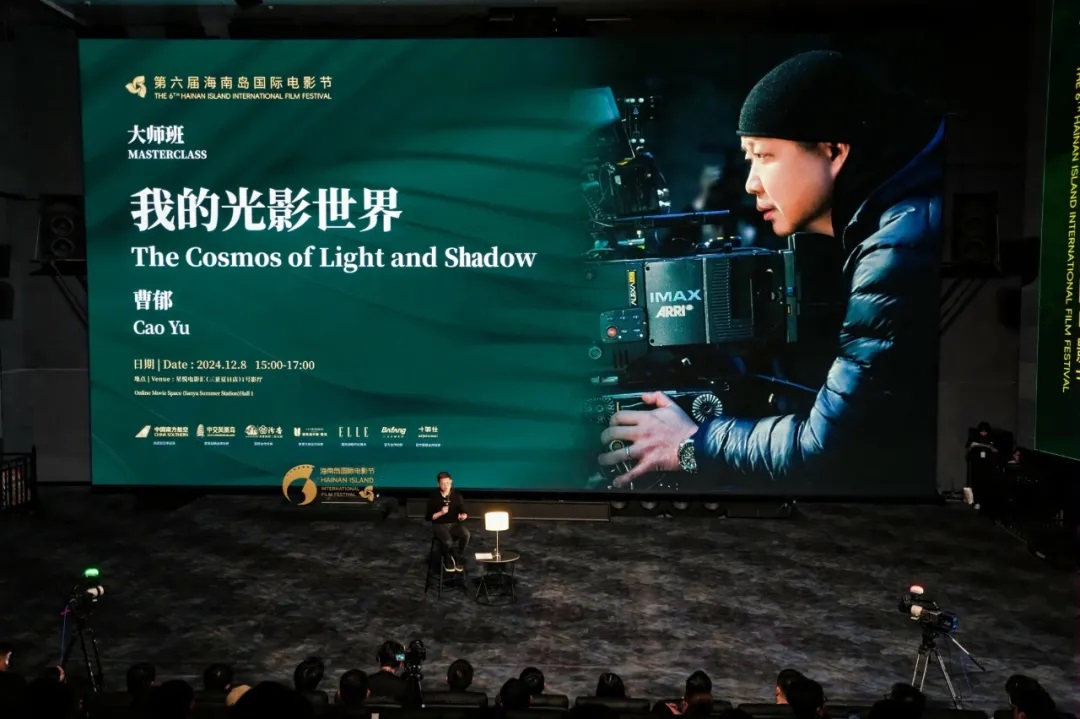
“When You’re Young, You Should Boldly Try All Kinds of Things”
Cao Yu recalled that his passion for cinematography started in middle school. When watching The Last Emperor (1987), he was deeply impressed by the film’s visual effects. He shared an early work of his, a short film shot with a video camera during his high school years. The content was simple, just scenes of clouds and the sun, but it reflected a young boy’s curiosity about the world and his desire to express himself.
Cao Yu’s career began with his collaboration with avant-garde theater director Meng Jinghui on shooting Chicken Poets (2002). He recalled, “That was my first time working with a famous director, and I felt pretty nervous.” Despite his lack of experience, he boldly incorporated all kinds of new filmmaking techniques into the film. “When you’re young, you should boldly try all kinds of things. Even though some of those approaches seem quite naive today, they were necessary steps in the path of growth.”
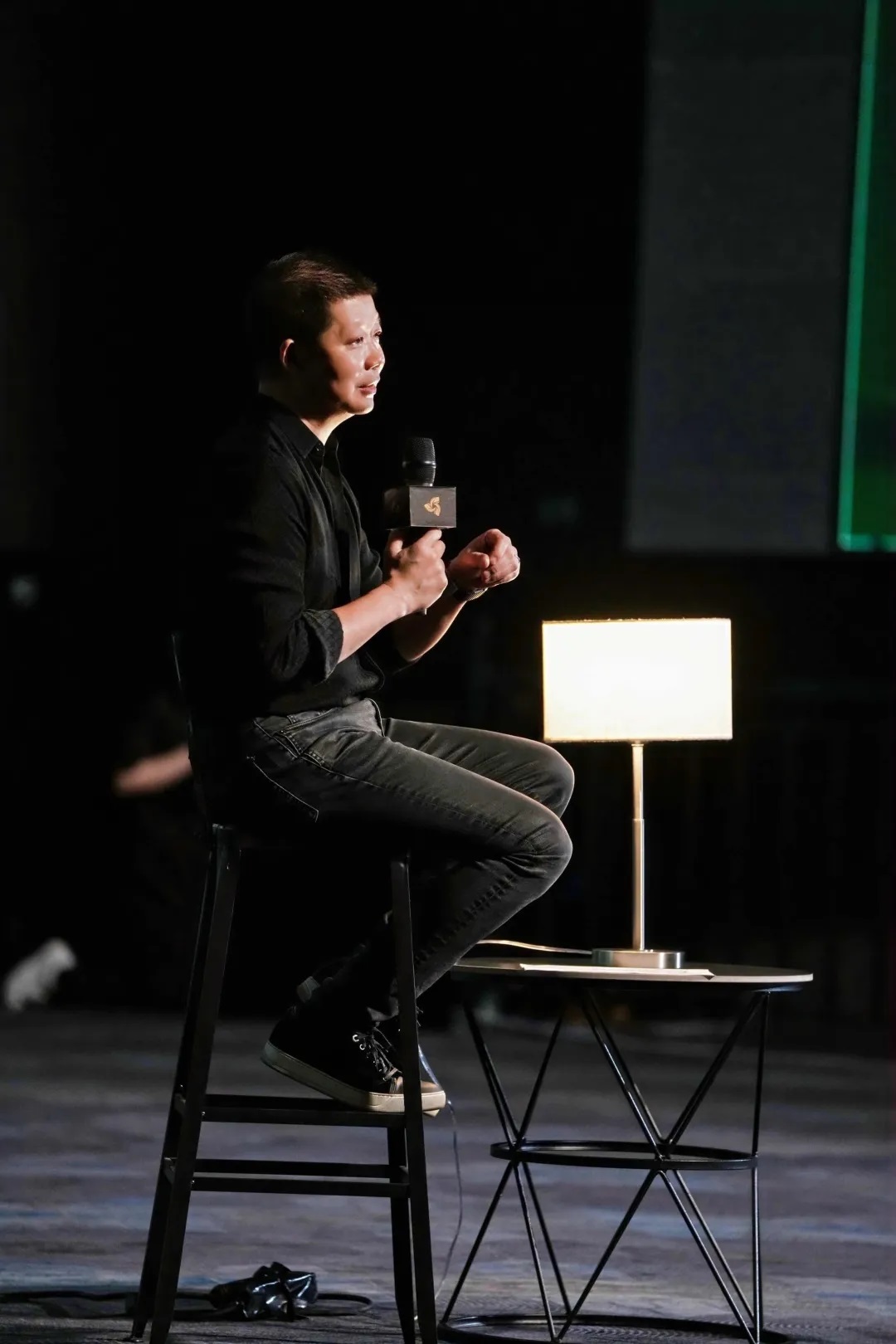
“Nature Provides the Answers to Life”
Kekexili: Mountain Patrol (2004) was Cao Yu’s first major work after entering the film industry, and the production was filled with hardships. While scouting locations with director Lu Chuan, he faced numerous challenges. The harsh natural environment of the filming site, including altitude sickness, lack of power, and limited equipment, made the production even more difficult. With only two cameras, three lenses, and one set of tracks, the conditions were as basic as a student project, which led him into a creative dilemma where he struggled to find solutions for a long time.
However, after much reflection, Cao Yu realized that he needed to let go of his preconceived designs and learn from nature. Previously, he had not thoroughly studied the subject of his shots, nor had he fully integrated the script with the natural environment. Therefore, he decided to follow nature, choosing shooting opportunities based on different times of the day and weather conditions and using natural light and shadow to give the images meaning, thereby creating an atmosphere aligned with the script.
The success of the film was deeply significant for Cao Yu. Not only did it earn him a cinematography award, but more importantly, it opened his heart. He reflected, “When shooting Kekexili: Mountain Patrol, nature called to me. Later, I had the feeling that nature gave you the answers to life.” The film taught him that the quality of cinematography is not only determined by visual styling and technical skills but also by the ability to understand the script and align with it. This understanding is crucial for the entire filmmaking team.
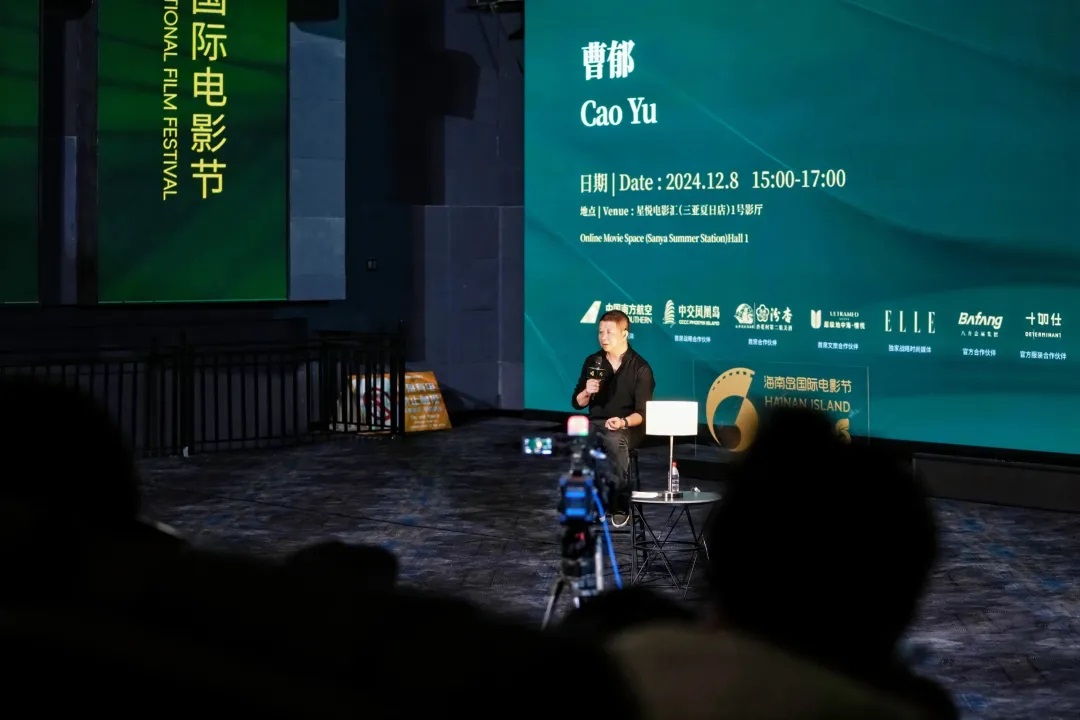
“The Landscape of Human Nature is the Most Important”
Different from Kekexili: Mountain Patrol, where the natural environment plays a central role, City of Life and Death (2009) stresses that “the landscape of human nature is the most important.” To highlight this, Cao Yu considered shooting with black-and-white film, as black and white has a “purifying” quality that allows the audience to focus on the actors’ “eyes” and “faces.” “This is a film about the face, not the environment,” he explained.
“You need to turn your ideas into something visual.” To convince investors and partners, they produced both colored and black-and-white test footage. Ultimately, based on the results of these test films, they chose the black-and-white film.
When the shooting began, Cao Yu found himself anxious despite having a generous budget and a wide array of equipment. Even though the initial test footage featured luxurious setups, the results “weren’t so excellent,” making him feel that the black-and-white photography was “a bit pretentious.” So, he experimented with handheld shooting, and Lu Chuan also recognized the unique feeling this method brought. Cao Yu explained that handheld shooting, much like filming with a phone, is a “completely improvised response” where the cameraman alone decides all the movement of the frame. This gave the film a stronger sense of presence and realism.
The shooting of City of Life and Death lasted for eight months, and this process gave Cao Yu a unique and rare experience. He felt a “sense of relaxation” like never before. He said, “It’s not because you’ve won awards or anything like that and feel relaxed. It’s because you care so much about the content and you like these actors so much that you’ve forgotten about yourself, and, naturally, you become relaxed.” This sense of relaxation not only helped him become more focused on the shooting but also added a unique charm to the film.
Cao Yu believed that a good film is like a series of moments in life. City of Life and Death made him feel as if he were in Nanjing in 1937. Reflecting on the marvelous nature of filmmaking, he said, “Film is about capturing yourself by yourself.” When the film presents the ideal effect, it feels like the film itself has come to life.

“The Call of the God of Film”
Cao Yu acknowledged that The Eight Hundred (2020) was the “most complex film” he had ever worked on. Its war theme is similar to City of Life and Death, and it also involves big-budget production, presenting enormous challenges. In terms of creative direction, he believed the film’s core lay in the “contrast between light and darkness,” a concept reflected in the phrase he used in his cinematography statement, “In the darkest night, there is the brightest light.” This idea runs throughout the entire film, especially in the night scenes, where the struggle between life and death is emphasized through the contrast of light and shadow.
To avoid repeating himself, Cao Yu decided not to use black-and-white photography but instead create a “colored black film” style. He designed the southern bank with stronger colors, drawing inspiration from the photography of figures like Saul Leiter, as well as scenes from cities like New York and Paris. At the same time, he based the design on the architecture of Shanghai. By contrasting the colors of the southern bank with the brutal battle scenes inside the warehouse on the northern bank, he amplified the visual impact. This approach allowed light to shine from the southern bank, which symbolized life, into the northern bank warehouse, creating a unique atmosphere that enabled the audience to feel the conflict between hope and reality.
The success of the film cannot be separated from the power of collective efforts. Cao Yu reflected that The Eight Hundred made him profoundly realize that film is the culmination of collective power. The indescribable rapport and rhythm during the filming felt as if they were being “called by the god of film.” Every moment was perfect, showcasing the film in its best form, which filled him with awe for filmmaking. This work became another milestone in his career.

“You Can Keep Moving Forward Forever”
After The Eight Hundred, Cao Yu took on a totally different project, The Cord of Life (2022). When the original cameraman left midway through production, Cao Yu stepped in to take on the crucial responsibility of shooting. The contrast was stark: from the two thousand lights in The Eight Hundred to just twelve in The Cord of Life. The significant reduction in resources made him feel “very unaccustomed,” as he was used to the big-budget scene.
Although the conditions were poor, even “simpler” than in Kekexili: Mountain Patrol, with only a single camera drone remaining, Cao Yu found himself experiencing an unprecedented sense of ease. Without the pressure of thousands of extras waiting to shoot, the shoot returned to simplicity, relying on light from nature. Moonlight served as the background light, and real firewood was burned on set, infusing the film with a unique feeling of hustle and bustle. Cao Yu candidly said, “For me, The Cord of Life is a very important film. I think I did a pretty good job. It’s one of my representative works because it allowed me to rediscover a part of myself from the past.”
This film held special meaning for Cao Yu, as it provided answers about life and death. During the filming, Cao Yu’s mother passed away. The heavy blow did not break him; instead, he integrated this emotion into the film’s creation. The final scene of the film features a farewell between a son and his mother. At that moment, Cao Yu had just rushed back from a hospital in Beijing. He set aside his grief and calmly immersed himself in the shooting. “Every shot was designed by me. You could say it’s very much like a mother using this film as a medium. Like teaching a child to walk, first the left foot, then the right foot, each shot feels like taking a step, teaching you how to move forward with each step.” The scene, full of emotion and release, was filmed just as dawn broke. Standing in the vast Inner Mongolian fields, Cao Yu gazed at the set still emitting faint smoke, and felt a profound sense of being at a loss, mixed with realization. “It felt like you had gained something, which was the light emerging in the film and the sparks from the fire. As they drifted away with the wind, you suddenly realize that life is like this and you can keep moving forward forever.”
From the earliest short films to the latest works, these films have coincided with many key moments in his life. In Cao Yu’s mind, “Film is a lifelong pursuit and film is the most perfect dream.”

“People Are Always More Important Than Machines”
During the interactive session, Cao Yu actively engaged with the audience, answering several questions regarding filmmaking. When asked about the challenge of limited equipment and funding for young directors, he advised, “For student graduation projects that aren’t intended for theatrical release, the choice of camera is more flexible. The key is to focus on shooting itself and try your best to find good collaborators, such as actors and cameramen. After all, ‘people are always more important than machines,’ and this is crucial to maximizing the personal style of the film.”
When one audience asked about how to balance artistic pursuit with commercial considerations during the creative process, Cao Yu responded, “In my view, good art and commercial interests are not contradictory to each other. For example, in some films I’ve been involved in, although commercial factors must be considered, I always insist that the visual presentation must be unique and artistic. Only by creating images that are high in quality and depth can you attract audiences to the cinema. From a long-term perspective, this is also a guarantee of commercial success.”

Starting from his personal creative practice, Cao Yu delved into the insights he has gained throughout his life. During this masterclass, he fully showcased his cinematographic style of “poetic realism,” providing valuable experience and inspiration to filmmakers and enthusiasts and injecting new vitality and thought into the development of cinematic art. We look forward to seeing future filmmakers build upon these experiences, continue innovating, and bring more remarkable works to the audience.

Copyright © www.hiiff.net All Rights Reserved.


